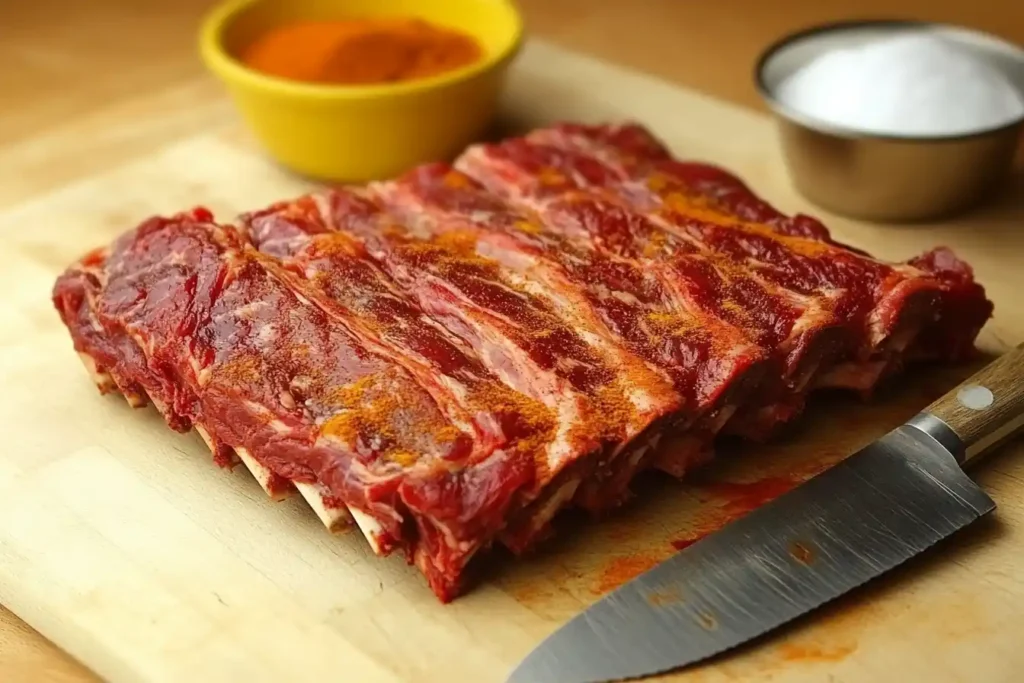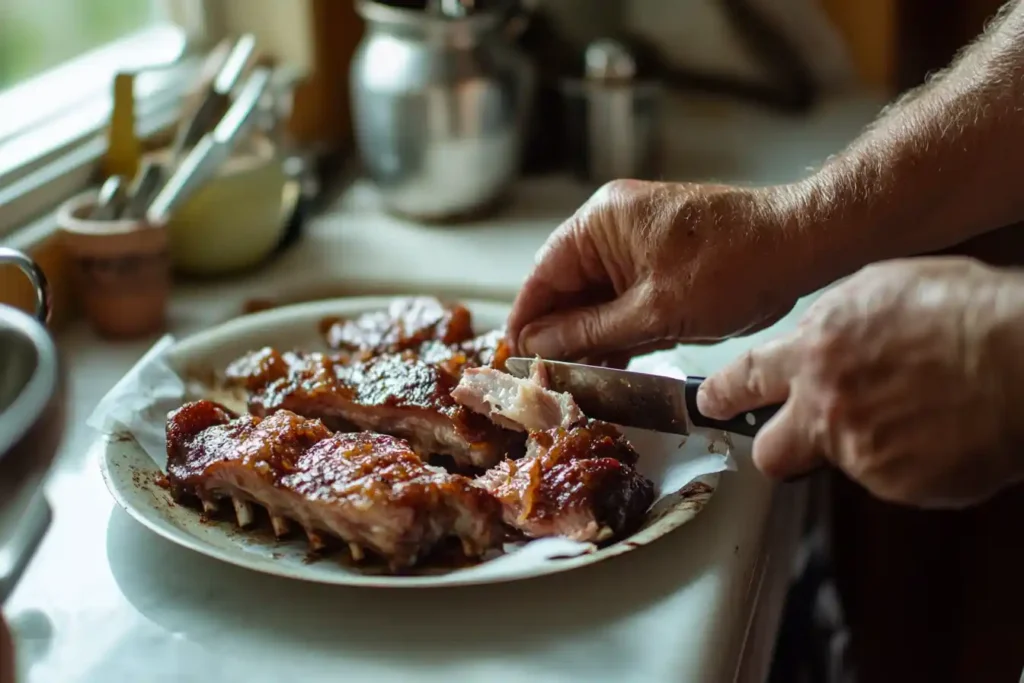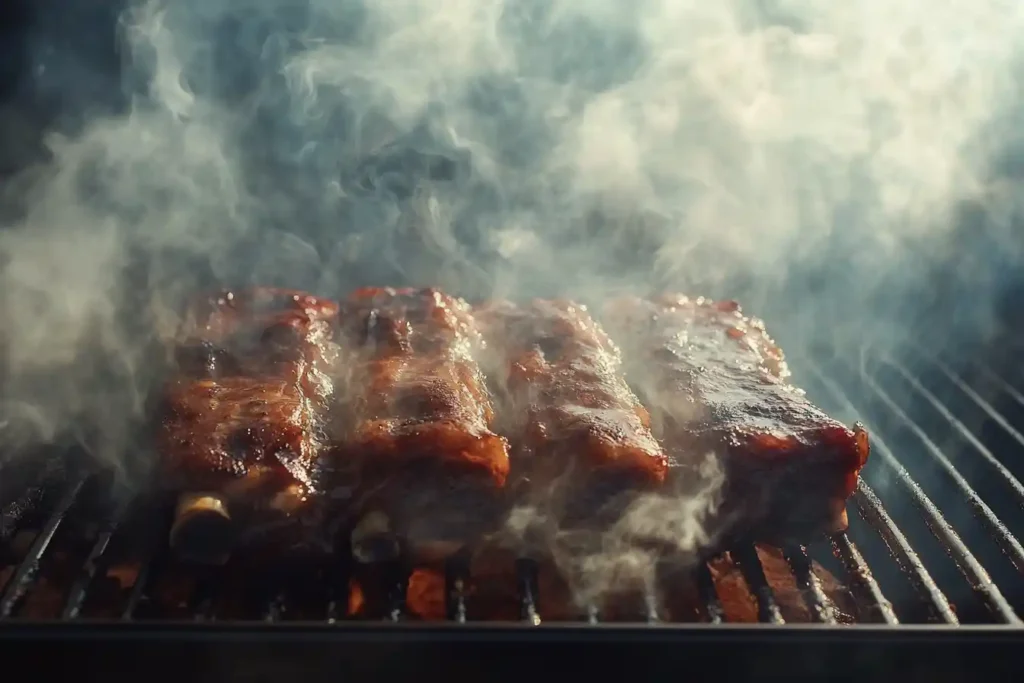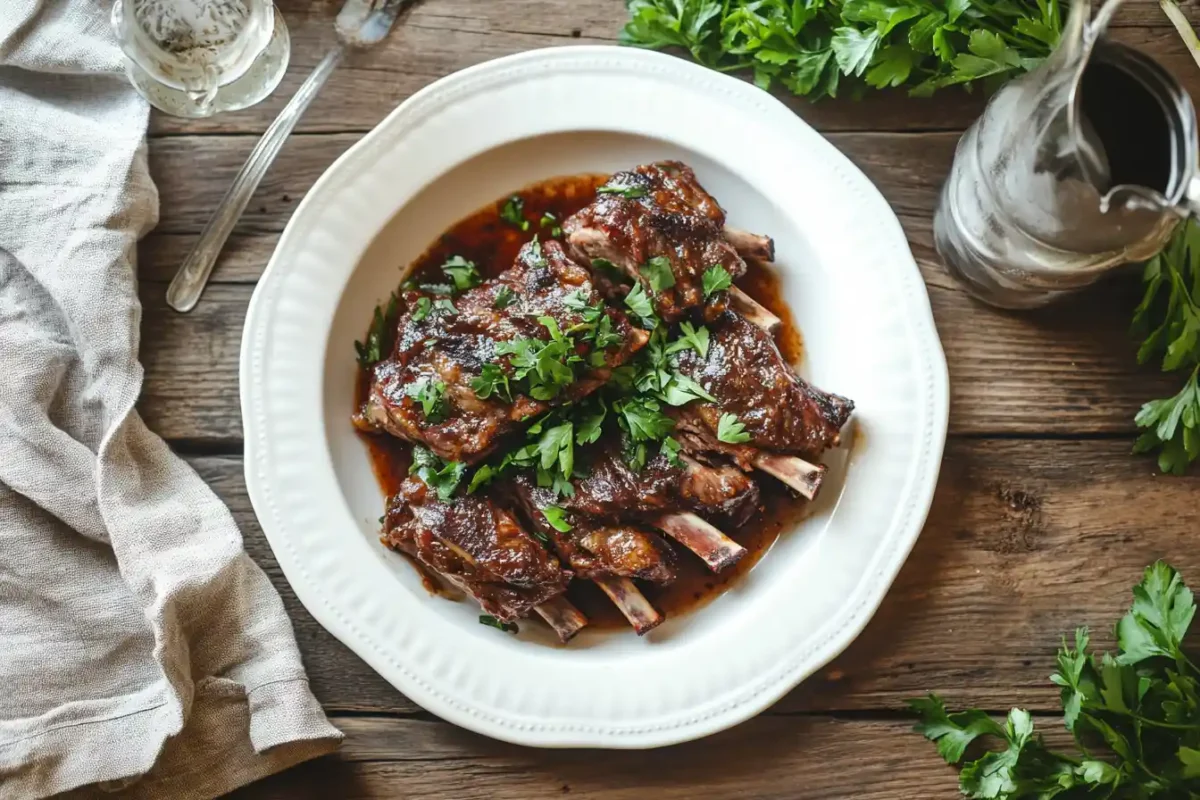Part 1: Introduction to Beef Back Ribs
Beef back ribs come from the upper part of the cow’s rib section, typically cut from the primal rib area. They’re the bones left after the rib roast, commonly known as prime rib, is removed. Unlike short ribs, these are longer, thinner, and packed with flavorful meat. The unique marbling of fat in this cut makes beef back ribs exceptionally juicy when cooked properly.
But wait—there’s more! These ribs are a favorite for their versatility. Whether you bake, smoke, or grill them, the result is always mouthwatering. Plus, they’re an excellent choice for anyone looking for a hearty meal option with a robust beefy flavor.
Why Choose Beef Back Ribs?
Why go for beef back ribs over other rib cuts? Well, here’s the thing: they’re not only easier to cook but also more affordable than premium cuts like brisket. Moreover, their distinctive marbling makes them perfect for absorbing the flavors of seasonings, marinades, and sauces.
Did you know that beef back ribs are also rich in protein and essential vitamins like B12 and iron? This makes them a nutritious option as well. Whether you’re feeding a crowd or just treating yourself, these ribs bring the perfect mix of indulgence and nourishment.
In addition to their incredible flavor, beef back ribs offer a good balance of nutrients. Here’s the nutritional breakdown per 100 grams
| Nutrient | Per 100g |
|---|---|
| Calories | 290 kcal |
| Protein | 20 g |
| Fat | 23 g |
| Saturated Fat | 9 g |
| Cholesterol | 85 mg |
| Sodium | 70 mg |
| Iron | 2.5 mg |
Part 2: Selecting and Preparing Beef Back Ribs
How to Select Quality Beef Back Ribs

When it comes to creating the perfect beef back ribs recipe, it all starts with choosing the right ribs. Not all beef back ribs are created equal, so knowing what to look for is key to ensuring a flavorful and satisfying meal. If you enjoy other beef recipes, you might like this beef tenderloin crock pot recipe.
Freshness Indicators
Freshness is non-negotiable when picking beef back ribs. Always inspect the color of the meat—it should have a rich, red hue, indicating freshness. Pale or grayish meat is a sign that it’s past its prime. The smell test is another essential step; fresh beef should have a clean, neutral aroma, while an off smell means it’s time to move on.
Additionally, check the sell-by date if you’re buying packaged ribs. Opt for ribs that have a tight vacuum seal, as this preserves their freshness and keeps them juicy until you’re ready to cook.
Understanding Marbling
Marbling is the web-like pattern of fat running through the meat. This fat is your friend—it melts during cooking, infusing the ribs with moisture and enhancing their flavor. Look for ribs with moderate marbling, as too much fat can be overwhelming, while too little might leave the meat dry and tough.
You’ll also want to select ribs with a good amount of meat clinging to the bones. Avoid racks that are too “shaved,” as they might have less meat and more bone.
Preparing Beef Back Ribs for Cooking
Preparation is the secret to making beef back ribs tender, juicy, and flavorful. It might seem like an extra step, but trust me, it’s worth every minute.
Trimming Excess Fat

While some fat is essential for flavor, too much of it can lead to greasy results. Use a sharp knife to trim away the thick, white layers of fat from the ribs. Focus on areas where the fat is dense and doesn’t naturally melt during cooking. But be careful! Leave enough fat to keep the ribs moist and prevent them from drying out.
Removing the Membrane
Here’s a pro tip: always remove the tough, silvery membrane from the back of the ribs before cooking. Why? This layer doesn’t break down during cooking, which can make your ribs chewy and less enjoyable to eat.
To remove it, slip a butter knife under one edge of the membrane, near the bones. Loosen a small section, then grab it with a paper towel for better grip, and pull it off in one go. It might take a bit of effort, but once it’s gone, your ribs will be much more tender and absorb flavors like a dream.
Part 3: Cooking Methods for Beef Back Ribs
Cooking beef back ribs can be an adventure filled with rich aromas and mouthwatering flavors. From the simplicity of oven-baking to the smoky charm of grilling and the depth of smoking, every method brings its own unique appeal. Discover the best cooking method for beef tenderloin for more ideas.Let’s explore how to cook beef back ribs to perfection.
Oven-Baked Beef Back Ribs
Sometimes, the easiest methods yield the best results, and oven-baking is no exception. This method is perfect for achieving tender, juicy ribs with minimal effort.
Step-by-Step Guide
- Preheat your oven: Start by preheating your oven to 275°F (135°C). Low and slow is the name of the game here!
- Season the ribs: Generously rub your ribs with a dry spice mix of your choice. Common options include paprika, garlic powder, onion powder, salt, and pepper.
- Wrap in foil: Place the ribs on a baking sheet, meat-side up, and wrap them tightly in aluminum foil. This traps steam, helping the ribs stay moist.
- Bake to tenderness: Cook the ribs for about 3 hours or until they’re tender and the meat easily pulls away from the bone.
- Add the sauce: For extra flavor, brush the ribs with barbecue sauce and broil them for 5–7 minutes until the sauce caramelizes.
Temperature and Timing
Keep an eye on internal temperature—a thermometer should read at least 190°F (88°C) for fall-off-the-bone tenderness. Remember, patience is key when oven-baking ribs.
Grilled Beef Back Ribs
Grilling brings a smoky, charred flavor that’s hard to resist. This method is ideal for summer cookouts or whenever you crave a bit of outdoor flair.
Direct vs. Indirect Grilling
- Direct grilling: Best for a quick char, but be careful not to overcook. Cook ribs over direct heat for just a few minutes to get a crust, then switch to indirect heat for thorough cooking.
- Indirect grilling: Place the ribs away from the flame and let the indirect heat work its magic. This slower method cooks the meat evenly and keeps it tender.
Achieving the Perfect Char
Start by preheating the grill to medium heat (about 350°F or 175°C). After seasoning, place the ribs on the grill and cover the lid. Use tongs to flip them occasionally for even cooking. Brush them with barbecue sauce during the final 10 minutes for a perfectly caramelized glaze.
Smoked Beef Back Ribs

Smoking takes beef back ribs to a whole new level of flavor. With the right wood chips and technique, you’ll achieve a deep, smoky taste that’s unforgettable.
Selecting Wood Chips
The type of wood chips you use has a significant impact on flavor. Popular choices for beef ribs include:
- Hickory: Strong and smoky, perfect for beef.
- Oak: A balanced flavor that complements ribs beautifully.
- Mesquite: Bold and earthy, great for an intense smoky taste.
Smoking Techniques
- Preheat the smoker: Set your smoker to 225°F (107°C). Low and slow is essential for smoking.
- Season and place ribs: Rub the ribs generously with your spice mix and place them bone-side down on the smoker grates.
- Add wood chips: Place the soaked wood chips in the smoker box to infuse the meat with smoke.
- Smoke to perfection: Let the ribs smoke for about 5–6 hours, checking occasionally to ensure the smoker maintains a consistent temperature. Use a meat thermometer to confirm an internal temperature of 190°F (88°C).
Part 4: Seasoning and Sauces
When it comes to making mouthwatering beef back ribs, the right seasoning or sauce can make all the difference. Whether you prefer a dry rub, a flavorful marinade, or a rich barbecue sauce, these options elevate your ribs to restaurant-quality perfection.
Dry Rubs for Beef Back Ribs
A dry rub is a blend of spices that creates a flavorful crust on your ribs, sealing in moisture and enhancing the natural beefy taste.
Essential Spices
The foundation of a great dry rub lies in the balance of sweet, savory, and spicy flavors. Here’s a classic mix to try:
- Paprika: Adds a smoky flavor and vibrant color.
- Garlic powder and onion powder: Essential for depth and aroma.
- Brown sugar: Balances the spice with a touch of sweetness.
- Chili powder: For a hint of heat.
- Salt and pepper: Brings out the natural flavors of the meat.
Feel free to experiment with additional spices like cumin, cayenne, or even coffee grounds for a unique twist! For a flavor-packed recipe, check out this pollo asado recipe.
Application Tips
For best results, pat the ribs dry with paper towels before applying the rub. Sprinkle the seasoning mix evenly over both sides, then massage it into the meat with your hands. Let the ribs sit for at least 30 minutes—or overnight in the refrigerator—to allow the flavors to penetrate.
Marinades for Beef Back Ribs
A marinade is perfect for infusing your ribs with bold flavors and tenderizing the meat simultaneously.
Flavor Combinations
The possibilities are endless, but here are two popular marinades to get you started:
- Asian-inspired marinade: Soy sauce, ginger, garlic, honey, and sesame oil.
- Citrus-herb marinade: Fresh orange juice, lime juice, olive oil, garlic, and chopped rosemary.
Marinating Duration
To maximize flavor, marinate your ribs for at least 2–4 hours. For an even deeper infusion, let them soak overnight in the refrigerator. Be sure to use a resealable plastic bag or a covered dish to keep the marinade sealed in and avoid cross-contamination.
Homemade Barbecue Sauces
Nothing complements beef back ribs like a good barbecue sauce. Store-bought options are convenient, but homemade sauces offer unbeatable freshness and flavor.
Sweet and Tangy Sauce Recipe
This classic sauce is perfect for those who love a balance of sweetness and tanginess.
- Ingredients: 1 cup ketchup, ½ cup apple cider vinegar, ¼ cup brown sugar, 2 tbsp Worcestershire sauce, and 1 tsp mustard powder.
- Instructions: Combine all ingredients in a saucepan over medium heat. Simmer for 10–15 minutes, stirring occasionally, until thickened.
Spicy Sauce Recipe
For a bold, fiery kick, try this spicy barbecue sauce:
- Ingredients: 1 cup tomato paste, ½ cup hot sauce, 2 tbsp honey, 1 tbsp smoked paprika, and 1 tsp cayenne pepper.
- Instructions: Mix ingredients in a bowl and adjust spice levels to taste. Heat gently before serving.
Part 5: Serving Suggestions
Perfectly cooked beef back ribs deserve equally delightful accompaniments. Whether you’re hosting a backyard barbecue or a cozy family dinner, choosing the right side dishes and drinks completes the experience. Let’s explore some classic options that pair beautifully with beef back ribs.
Side Dishes to Complement Beef Back Ribs
Every great rib meal starts with the right sides, and these classics never fail to impress.
Classic Coleslaw
Coleslaw offers a refreshing crunch and tanginess that complements the rich, smoky flavors of beef back ribs. Prepare it with shredded cabbage, carrots, and a dressing made of mayonnaise, apple cider vinegar, and a touch of honey. Not only does coleslaw balance the heaviness of the ribs, but it also adds a vibrant pop of color to your plate.
Baked Beans
Nothing says comfort food like baked beans. Slow-cooked with brown sugar, molasses, and a hint of smoked paprika, these beans add a sweet, savory dimension to your meal. Serve them warm alongside your ribs for a pairing that’s both hearty and satisfying.
For additional variety, consider adding cornbread, roasted vegetables, or even mashed potatoes to round out your plate.
Beverage Pairings
The right drink elevates the rib-eating experience, complementing the flavors while refreshing your palate.
Non-Alcoholic Options
For a family-friendly feast, try iced tea with a splash of lemon, sparkling water infused with citrus slices, or a classic homemade lemonade. These beverages provide a crisp, refreshing counterpoint to the richness of the ribs.
For a creative twist, consider serving spiced apple cider or a fizzy ginger ale mocktail. These drinks bring depth and character without overpowering the meal.
Part 6: Frequently Asked Questions About Beef Back Ribs
When cooking beef back ribs, it’s natural to have a few questions. Here, we’ll address common concerns to ensure your ribs turn out tender, flavorful, and perfect every time.
The best cooking method depends on your desired results and available equipment.
Oven-baking is ideal for tender, fall-off-the-bone ribs and is perfect for beginners.
Grilling is great for those who love a smoky flavor and a caramelized crust.
Smoking delivers the deepest flavor and is best suited for those with time and a smoker.
Not exactly! Beef ribs come in two main cuts:
Beef back ribs: These are cut from the upper part of the rib section, near the spine. They’re long and meaty, with rich marbling.
Short ribs: Taken from the lower section near the belly, short ribs are smaller, fattier, and best suited for braising or slow cooking.
Beef back ribs are excellent for barbecues, family dinners, or any occasion where you want a hearty, crowd-pleasing dish. They’re versatile, pairing well with various seasonings and sauces, and are perfect for oven-baking, grilling, or smoking.
Beef ribs should be cooked low and slow to break down the connective tissue and achieve tenderness. Depending on the method, here’s how you can cook them:
Oven: Bake at 275°F (135°C) for about 3 hours.
Grill: Use indirect heat at medium temperatures (350°F or 175°C).
Smoker: Smoke at 225°F (107°C) for 5–6 hours with your choice of wood chips.
Conclusion For Beef Back Ribs
Cooking beef back ribs isn’t just about making a meal—it’s about creating an experience. From selecting the freshest cuts to seasoning them with care and choosing the perfect cooking method, every step adds a layer of flavor and texture that transforms these ribs into something truly special.
Whether you prefer the convenience of oven-baking, the smoky char of grilling, or the rich depth of smoking, there’s a method to suit every palate. Pair them with classic sides like coleslaw and baked beans, and you’ve got a feast that’s sure to impress family and friends alike.
Don’t forget, the right seasoning or sauce can elevate your ribs to restaurant-quality perfection. A flavorful dry rub, a tangy marinade, or a homemade barbecue sauce will infuse your ribs with irresistible taste.
Ultimately, the best beef back ribs recipe is the one that brings you joy, satisfies your cravings, and leaves everyone at the table asking for seconds. So, grab those ribs, fire up your oven or grill, and get cooking—your perfect plate of beef back ribs awaits!
For more tips and inspiration, explore some of the recipes and resources mentioned in this guide. Happy cooking!

